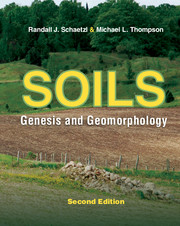13 - Soil Genesis and Profile Differentiation
Published online by Cambridge University Press: 12 January 2024
Summary
The formation of a soil from raw parent material (or a preexisting soil) defi nes soil genesis, or pedogenesis . The study of pedogenesis is called pedology . Amundson (1998) noted that during its formative period, pedology focused on observation of soil properties, so as to unravel the causes and processes that formed those soils. Wilding (1994: 16) provided perhaps the most complete defi nition of pedology, as
the component of Earth science that quantifi es the factors and processes of soil formation, including the quality, extent, distribution, spatial variability, and interpretation of soils from microscopic to megascopic scales.
Considering scale in pedology is important, for soils can be, and are, studied at a wide range of scales (Fig. 3.14). Today, we often think of pedology as simply the study of soil genesis (the focus of this chapter) and classifi cation (the focus of Chapter 8).
Landscapes: Can a soil Become extinct?
Although soils seem to be everywhere, some soil types are rare. They occur only in isolated areas where unique combinations of state factors converge, thereby epitomizing the concept of soil endemism (Bockheim 2005). The loss of these soils often accompanies the loss of endemic vegetation types, as is the case with many serpentinitic soils (Spence 1957 , Proctor and Woodell 1975 , Mansberg and Wentworth 1984, Kram et al. 2009, Rajakaruna et al. 2009, Weerasinghe and Iqbal 2011), marl soils (Bartgis and Lang 1984), and the soils at Hans Jenny's famous pygmy forest (Jenny et al. 1969). Drohan and Farnham (2006) went so far as to defi ne rare versus threatened soils. Simply put, a rare soil is of limited areal extent, e.g., Guo et al. (2003). A threatened soil may have a greater areal extent but is undergoing a transformation that alters its characteristics and function, making it less able to carry out that function, e.g., growing food or supporting a native ecosystem.
Some, more extensive soils are also at risk due to human activities or climate change, i.e., unintended changes in the state factors. Many Gelisols are in danger of losing their underlying permafrost, because of our globally warming climate (Stokstad 2004 , Pearce 2006). The result would be a soil system that is dramatically different from the one in which the soils formed.
- Type
- Chapter
- Information
- SoilsGenesis and Geomorphology, pp. 321 - 442Publisher: Cambridge University PressPrint publication year: 2015



